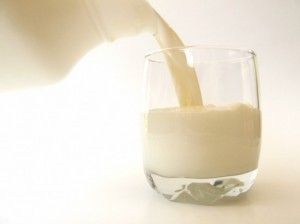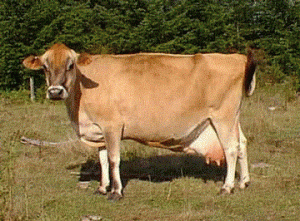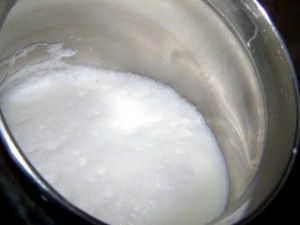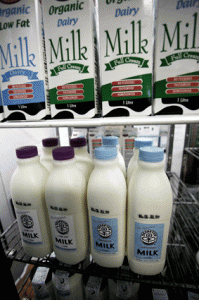It’s Healthy Bones Week
English cookery writer Constance Spry once advised that the first step towards making a perfect junket was to use milk “warm from the cow.”
Quaint, eh?
I remember many years ago when we were living in the country and my mother would send my sister and I to collect the daily pail of milk from the nearby dairy. It would slop and spill all over the car floor as we drove back on the bumpy road, but the rewards were always more than worth the trouble. Fresh warm frothy milk to pour over our cereal for breakfast or for my mother to make custard or junket with for dessert that night.
These days, I need a PhD to know which milk to use – store-bought, it’s pasteurised (which kills bacteria and extends shelf life) homogenised (which shatters fat particles so they don’t rise to the top and form cream) packaged in cardboard or plastic containers and then chilled before I can get to it. It’s hard enough figuring out which one will go best with my cereal, let alone which one to buy for the kids or the cat or dog.
There’s only one thing I am sure of – that milk is the richest dietary source of calcium which in turn is very important for healthy bones.
Generally I go for regular milk (or full cream milk) because I prefer the taste. Also, since I discovered it’s not so high in fat after all (3.8 per cent) I don’t feel so guilty about using it. It’s also the best milk for toddlers because it contains fat which helps them absorb vitamins A and D. I also buy reduced fat/calcium enriched milk because I know it’s high in calcium (essential for healthy bones) and protein and contains virtually no fat. However it does lack vitamins A and D and is not advisable for people who are lactose intolerant.
Then there’s skim milk which contains almost no fat nor vitamins A and D but has the same calcium level as regular milk; vitamin-enriched milk and milk with added iron which come in full cream or fat-reduced varieties; reduced–fat milk (1.2 – 1.6 per cent fat); flavoured milks which are an excellent source of calcium but have a higher Kj level than plain milk; buttermilk which is a cultured milk made from skim milk, is low in fat and has a tangy flavour (excellent for making scones, muffins and pancakes) and organic milk. All these come from the good old moo-cow and are important sources of calcium, a very important nutrient at all ages. For those who find cow’s milk hard to digest or are lactose intolerant other milks (like goats’ and soy ) are also available.
Cows milk is best purchased daily and kept in the refrigerator (below 4 degC) away from strong-smelling foods with the container properly closed.
Apart from its consumption as a beverage, it has many uses in cooking. Bechamel (white) sauce, ‘ragu’ (bolognese sauce), soups (like chowders and vichyssoise), cakes, crepes, blancmange, sweet yeast breads and even some casseroles require the creamy luxuriousness of milk.
And where would cappuccino and café latte drinkers be without it?
All these come from the good old moo-cow and are important sources of calcium, a very important nutrient at all ages. For those who find cow’s milk hard to digest or are lactose intolerant other milks (like goats’ and soy ) are also available.
Cows milk is best purchased daily and kept in the refrigerator (below 4 degC) away from strong-smelling foods with the container properly closed.
Apart from its consumption as a beverage, it has many uses in cooking. Bechamel (white) sauce, ‘ragu’ (bolognese sauce), soups (like chowders and vichyssoise), cakes, crepes, blancmange, sweet yeast breads and even some casseroles require the creamy luxuriousness of milk.
And where would cappuccino and café latte drinkers be without it?
 All these come from the good old moo-cow and are important sources of calcium, a very important nutrient at all ages. For those who find cow’s milk hard to digest or are lactose intolerant other milks (like goats’ and soy ) are also available.
Cows milk is best purchased daily and kept in the refrigerator (below 4 degC) away from strong-smelling foods with the container properly closed.
Apart from its consumption as a beverage, it has many uses in cooking. Bechamel (white) sauce, ‘ragu’ (bolognese sauce), soups (like chowders and vichyssoise), cakes, crepes, blancmange, sweet yeast breads and even some casseroles require the creamy luxuriousness of milk.
And where would cappuccino and café latte drinkers be without it?
All these come from the good old moo-cow and are important sources of calcium, a very important nutrient at all ages. For those who find cow’s milk hard to digest or are lactose intolerant other milks (like goats’ and soy ) are also available.
Cows milk is best purchased daily and kept in the refrigerator (below 4 degC) away from strong-smelling foods with the container properly closed.
Apart from its consumption as a beverage, it has many uses in cooking. Bechamel (white) sauce, ‘ragu’ (bolognese sauce), soups (like chowders and vichyssoise), cakes, crepes, blancmange, sweet yeast breads and even some casseroles require the creamy luxuriousness of milk.
And where would cappuccino and café latte drinkers be without it?




